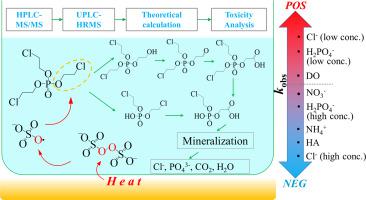Science of the Total Environment ( IF 8.2 ) Pub Date : 2021-12-07 , DOI: 10.1016/j.scitotenv.2021.152185 He Liu 1 , Jiahao Liang 1 , Xiaodong Du 1 , Rui Wang 2 , Ting Tang 1 , Xueqin Tao 3 , Hua Yin 4 , Zhi Dang 4 , Guining Lu 4

|
Organophosphorus esters (OPEs), one kind of the emerging contaminants with high frequency of detection, is rather refractory in natural environment, thus posing great threat to human health. This study investigated the feasibility and mechanism of tris(2-chloroethyl) phosphate (TCEP) degradation in thermally activated persulfate (TAP) system. Influence of impact factors, such as PDS dosage, temperature, initial pH, and presence of natural water matrix (Cl−, NO3−, H2PO4−, NH4+, humic acid), were evaluated. Results showed that 100% degradation of TCEP can be achieved in TAP system in 40 min at 60 °C. SO4·− as the dominant oxidant for TCEP degradation was proved by quenching experiment and verified by EPR analysis. Alkaline condition exerted great inhibitory effect by affecting the constituents of oxidative radicals. It is suggested that Cl− and H2PO4− at lower dosages promoted the degradation by stimulating ·OH production and forming oxidative radicals with better selectivity. Intermediates identified by high resolution mass spectrometer was suggested less toxic than TCEP by ECOSAR program. Meanwhile, the illustrated oxidation mechanism mainly involved radical attack at C Cl bond and cleavage of C
Cl bond and cleavage of C O bond, as further confirmed by frontier electron density calculation and wavefunction analysis. Moreover, cyclic degradation of TCEP indicated the constant release of SO4·− in 450 min, suggesting high efficiency and stability of PDS in TAP system. Four selected OPEs achieved complete removal in TAP system and their degradation discrepancy was further discussed based on the distinctive structures. Altogether, TAP technology can be used as an efficient method in TCEP removal with great potential for application.
O bond, as further confirmed by frontier electron density calculation and wavefunction analysis. Moreover, cyclic degradation of TCEP indicated the constant release of SO4·− in 450 min, suggesting high efficiency and stability of PDS in TAP system. Four selected OPEs achieved complete removal in TAP system and their degradation discrepancy was further discussed based on the distinctive structures. Altogether, TAP technology can be used as an efficient method in TCEP removal with great potential for application.
中文翻译:

热活化过硫酸盐降解磷酸三(2-氯乙基)酯(TCEP):实验与理论研究相结合
有机磷酯(OPEs)是一种新兴的高检测频率污染物,在自然环境中不易降解,对人体健康构成极大威胁。本研究调查了磷酸三(2-氯乙基)酯(TCEP)在热活化过硫酸盐(TAP)体系中降解的可行性和机理。评估了影响因素的影响,例如 PDS 用量、温度、初始 pH 值和天然水基质(Cl -、NO 3 -、H 2 PO 4 -、NH 4 +、腐殖酸)的存在。结果表明,在 TAP 系统中,TCEP 可在 60°C 下在 40 分钟内实现 100% 的降解。SO 4 ·−作为TCEP降解的主要氧化剂,通过淬火实验证明,并通过EPR分析验证。碱性条件通过影响氧化自由基的成分而发挥很大的抑制作用。这表明较低剂量的Cl -和H 2 PO 4 -通过刺激·OH 的产生和形成具有更好选择性的氧化自由基来促进降解。经高分辨率质谱仪鉴定的中间体的毒性低于 ECOSAR 程序的 TCEP。同时,所示的氧化机制主要涉及自由基攻击 C  Cl 键和 C 的裂解。
Cl 键和 C 的裂解。 O键,通过前沿电子密度计算和波函数分析进一步证实。此外,TCEP的循环降解表明SO 4 ·-在450 min内不断释放,表明PDS在TAP系统中的高效性和稳定性。四个选定的 OPE 在 TAP 系统中实现了完全去除,并基于独特的结构进一步讨论了它们的降解差异。总而言之,TAP 技术可以作为一种有效的去除 TCEP 的方法,具有很大的应用潜力。
O键,通过前沿电子密度计算和波函数分析进一步证实。此外,TCEP的循环降解表明SO 4 ·-在450 min内不断释放,表明PDS在TAP系统中的高效性和稳定性。四个选定的 OPE 在 TAP 系统中实现了完全去除,并基于独特的结构进一步讨论了它们的降解差异。总而言之,TAP 技术可以作为一种有效的去除 TCEP 的方法,具有很大的应用潜力。

































 京公网安备 11010802027423号
京公网安备 11010802027423号